Trump’s case for mental health grant cuts is false logic and hurts students

Addiction is ugly. The ills of behavioral compulsion, drug addiction and alcoholism can’t be just shaken off. The first step to breaking free from any addiction is admitting you are powerless in the face of it. This step can be the hardest and the most contrary to linear reasoning, “Why would I admit that I am too weak to change something? Doesn’t that make it worse?”
No. Only in having full honesty and humility toward the issue can you grow in courage and self-discipline. The path forward isn’t always to try harder, do better, get over it …. especially when it concerns mental illness.
The best treatment is prevention but if you’re already in the woods, you need help.
How does this relate to the new federal mental health funding update?
We’re still in the woods with a mental health epidemic among young people.

This is not new news. It’s been over a decade in the making with the pandemic exacerbating it. It’s why the previous administration put a record number of government dollars toward the effort, earmarking $240 million dollars to launch and expand behavioral health care services in community mental health centers, put $70 million towards expanding the mental health workforce including in underserved communities, and also signed the Bipartisan Safer Communities Act in 2022 committing $1 billion in grant funding for school mental health workers in part to address school gun violence. (Yes, you read that correctly, bipartisan, the Republican senator from Florida, Marco Rubio, was the sponsor.)
And yet, the Trump administration recently cut the bipartisan grant to fund this $1 billion dollar initiative.
With one swipe of the pen, vital funding for school mental health workers was slashed, including counselors and social workers. Why? The administration stated that within the language of the bill was a hidden Diversity, Equity and Inclusion initiative.
To get a sense of who these dollars were directed at, let’s take a peek at how the kids are doing according to latest data available from the CDC:
Among U.S. high school students:
- 40% reported persistent feelings of sadness or hopelessness in the past year.
- 20% reported seriously considering attempting suicide in the past year.
These statistics are slightly better than mid-pandemic but reveal a devastating crisis in the broad view of a developing generation. Behind these numbers are the faces of our children. Self-harm through cutting, suicide.
Now for the latest numbers that address these kids as described above from the National Association of School Psychologists:
- The school psychologist ratio for Georgia is 1 for every 2,018 students.
- The preferred ratio is 1 for every 500 students.
The data says it all. Too many students are in need of mental health services and not enough mental health workers are there to help them.
The claimed conflation of DEI and mental health services is the justification for the school mental health services budget cuts. Diversity, Equity and Inclusion, DEI, is a framework of thought that has been controversial since its onset. It is most recently defined as hiring minority workers, investing in affirmative action protocols and fostering gender identity acceptance efforts. In a similar vein to affirmative action it has varying proponents and opponents across party platforms and political landscapes.
Mental health, on the other hand, is a field of science. Mental illness can be devastating, and treatment is regarded on par in practicality and acceptance as physical illness. If we go back 100 years, this statement just wouldn’t be true, as severe stigma existed toward psychology and psychiatry. It was regarded with suspicion at best and disdain at worst, however years of research and practice has legitimized the fields of study again and again. Mental health treatment for mental illness improves lives and can even save them.
Therapy and psychopharmaceuticals can be as life saving to a suffering individual as insulin is to a diabetic. When I go to sign my children up for summer camp these days, there are almost equal number of questions inquiring about their mental health status and history as their physical health and background.
The two topics of DEI and mental health do not intermingle in the broader narrative, nor are they to be used against each other as they in practice are two entirely different systems.
Claiming that the school mental health initiatives are interconnected to diversity, equity and inclusion is at its face false logic. Proper education, accreditation and certification is essential to settle the question of any provider’s personal or political bias. If mental health workers are qualified and trained professionals, they offer diagnosis and intervention, nothing more and nothing less. It’s no more racially, politically or religiously motivated than a primary care provider’s treatment. Mental illness is treatable and often preventable but action is key.
You can’t white-knuckle your way through a youth mental health epidemic. If you ignore the problem, it gets worse … think of the denial phase of the addict’s journey. We have to admit there is a problem, an incredibly complex one at that. Brain chemistry, genes, relationships with family and friends, online behavior and larger societal structures all play a symphony of roles. Maintaining healthy children and families requires all of society—including policy, institutional, and individual changes in how we view and prioritize mental health.
Cutting funding to school mental health services denies the problem, ignores the consequences and exacerbates the situation. It hurts the already-hurting kids.


